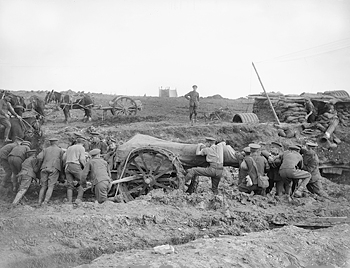
WWII: Maginot Line | Normandy | V-Weapon Sites | Arnhem
Further afield: Crete
| Home Tracing Military Ancestors Travel Advice CWGC Cemeteries Iron Harvest News Book Reviews Glossary Links Contact Me The Somme:
 
|
The Final BattlesMeanwhile, on the Fourth Army front, Rawlinson, now almost entirely controlled by Haig, was following up the limited successes at Flers-Courcelette and Morval against a fourth German defence line fixed on the Transloy ridge just a few kilometres short of Bapaume. Haig believed, with some justification, that the Germans had taken such a hammering in the preceding months that their front was close to collapse – that one last push would see the British break cleanly through once and for all. Haig optimistically set the eventual objective as Cambrai, more than 30 kilometres distant! Delayed by rain, the Battle of the Transloy Ridges began on 7th October with a three-corps attack (III, XV and XIV) between le Sars and Lesboeufs supported by the French to their right. There were some initial gains but the Germans had changed tactics to meet the devastating British barrages and began deploying machine-gunners just beyond the zone of the British creeping barrage but well within range of the advancing infantry. Further attacks on 12th and 18th October again met with failure. The autumn rain was now also aiding the Germans, churning the already tortured ground, preventing supplies and reinforcements reaching the front line, blocking the passage of artillery and obscuring the view of German positions and the fall of shell from the air. Living conditions of the men in the front line became atrocious as advanced positions, already temporised during the advance, became nothing more than mud-filled ditches. It should have become clear to all on the Fourth Army front that the time was fast approaching to call off the offensive. But doggedly Haig pressed on the attacks, each with ever more limited objectives. Isolated advances by the 1st Australian, 17th (Northern) and 33rd Divisions tried to gain ground north and east of Gueudecourt but all ultimately floundered. A further push to capture the feature known as the Butte de Warlencourt, just to the south of the Albert-Bapaume road, resulted in another 2,000 casualties with no gain. With reserves running out and pressure coming from many corps commanders to end the slaughter, Rawlinson at last called on Haig to end the fighting. But Haig was already looking to the north, to Gough's Reserve Army sector astride the River Ancre where the battleground had remained virtually untouched since the 1st July and where the new British artillery and infantry tactics might prevail. Haig still hoped that, although a breakthrough had eluded him, a stunning victory in the late autumn would be a favourable development ahead of the Chantilly conference with Joffre on 15th November. And so the last act of Somme took place, the Battle of the Ancre.
The offensive began well. Commencing in the early morning of 13th November under the cloak of darkness the II Corps, with the 19th (Western) and 39th Divisions attacking east of the Ancre, gained all its objectives within minutes aided by one of the most crushing artillery bombardments to date. North of the river, following behind a well-maintained creeping barrage, the 2nd and 51st Highland Divisions stormed forward to take the Redan Ridge and Beaumont Hamel whilst the 63rd (Royal Naval) Division also made good progress capturing Beaucourt on 15th November with the assistance of tanks. All the attacks were aided by the earlier capture of the redoubts around Thiepval on the opposite bank of the river that had so bedevilled the 1st July operations and by a morning mist that shielded the attack from German artillery observers. Only at Serre did the attack stall – again, inexplicably, wire remained uncut and the attacking divisions, the 3rd and 31st failed to take advantage of Russian saps – it all left a feeling of "déjà vu". Gough now hoped to capture Grandcourt and Miraumont using the newly won gains east of the River Ancre as a springboard. But it was not to be. More rain and snow began to envelop the battlefield, German defences remained strong and the offensive again broke down into piecemeal attacks. The Battle of the Ancre had claimed a further 23,000 British and Dominion casualties but they were to be the last. Haig belatedly called off any further attacks and the 1916 Battle of the Somme drew to a close. |
